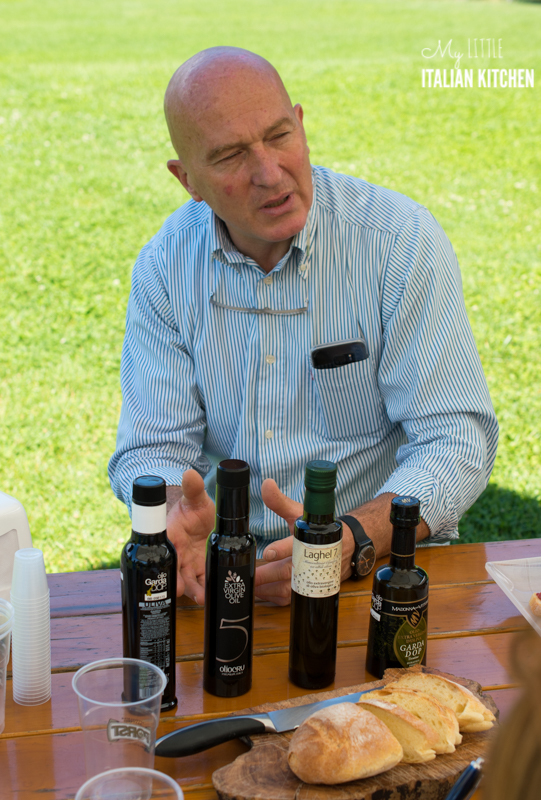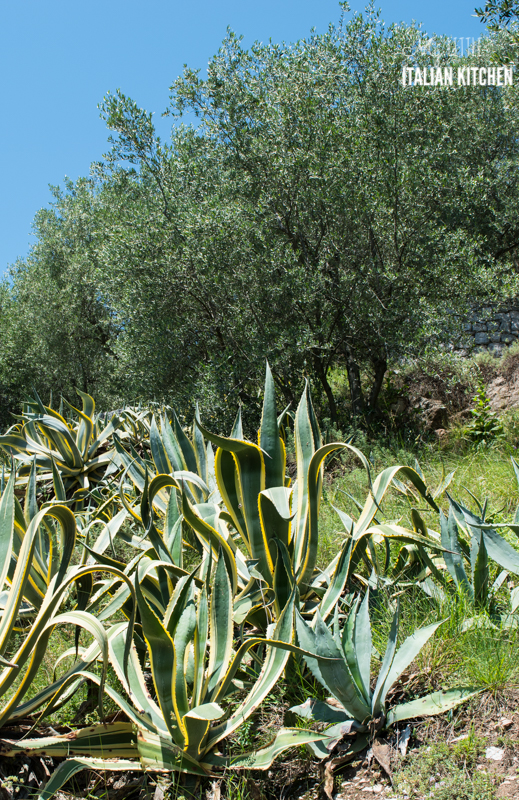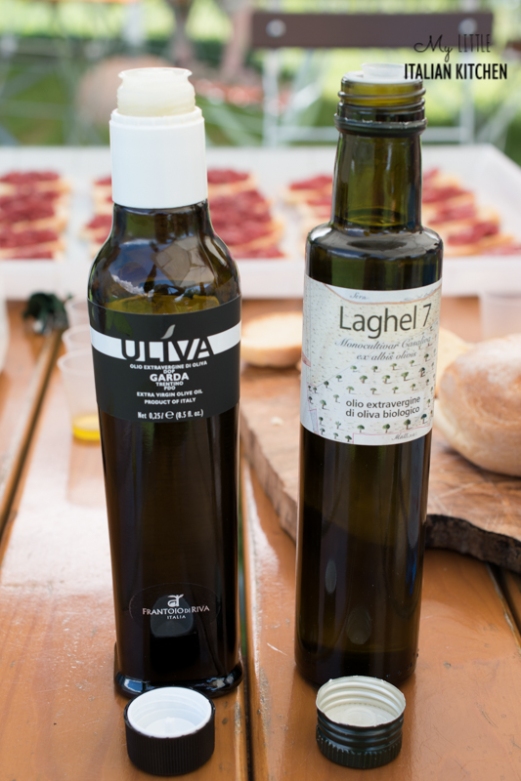People have said to me that when they buy olive oil at the supermarket they feel spoilt for choice. Really?
I have my doubts about this one.
Yes you can find different types of olive oil, but are they really as good as they state on the label? What are we really buying?
Olive oil is like wine, it takes time and experience to understand it but you can get a grasp on the matter and understand some basic concepts which can help you choose a good oil.
When I was on Lake Garda I was given a lesson on how to taste it by the president of the association of the olive oil producers at Agririva Mr Roberto Zampiccoli.
Lake Garda with its mild climate makes it possible to grow olive trees and there is a modest production of olive oil. This olive oil is mild, green in colour and delicate as opposed to olive oil produced in Southern Italy which is more yellowish in colour, slightly more bitter and more pungent in taste (due to the heat and the sunshine).
The spiciness of the olive oil is good and indicates the presence of polyphenols which have health-protective properties particularly against the aging effects and certain types of cancer.
We went up to the castle of Arco which is surrounded by olive groves.
The vegetation looked so very Mediterranean around this area.
There was a distintive smell of Jasmine everywhere. Is there a better natural perfume than jasmine?
We walked up the top of the hill there were olive trees everywhere.
I felt like I was in Southern Italy, the vegetation certainly did not look like the one typical from the Alps!
As soon as we reached the top we sat down and our masterclass on olive oil tasting began.
How do you taste olive oil?
- Pour a little oil into a small glass.
- Cup the glass with one hand and while you warm it up for a minute or two cover it with the other hand to trap the aromas inside so they won’t evaporate.
- Smell the oil: what can you smell? Fresh-cut grass? Almonds? Artichoke? A certain type of fruit?
- Sip a little bit of oil starting from the tip of your tongue and then suck air through the oil and breathe out through your nose then swallow some of the oil. Which flavours or perfumes can you taste?
It is said that pungency and a peppery sensation in your throat is a good sign. You can compare this to the heat of chilies. Sometimes this can be so powerful to make you cough.
Olive oil should always come in a dark bottle as it deteriorates quite quickly. It should not not be older than one year.
When you see olive oil sold in a clear glass bottle with a lovely green colour and it is unfiltered beware as this is done solely for marketing purposes: it looks good and the sediment tricks you into thinking you are buying a genuine natural product.
Industrial olive oil can be coloured using chlorophyll which makes it look really bright green and pretty.
You do not need the sediment (known as morchia or sludge) as this is just the residue which does not serve any purpose and it decays so it is best to buy filtered olive oil.
We were served a very generous tray of carne salada too which is typical from the area. It is raw meat preserved in salt and herbs. Delicious served on top of bread.
When the olives are harvested they need to be pressed within 10 hours in order to maintain their nutritious values and all its vitamins, but some olives are pressed within 4 hours. Most olive oil is organic as the olive trees do not need many treatments to grow healthily.
When you buy olive oil look for the DOP certificate which certifies the origin of the product.
Some of the olive oils you can find on lake Garda are: Uliva which olives are pressed within 4 hours, Olio Cru and Laghel which have won several awards and Madonna delle Vittorie.
A year ago a new EU law has introduced a special anti topping-up cap, which does not allow anyone to fill the bottles used with a different oil not conforming to the original. This means that the oil can only get out and cannot be refilled. This is to prevent restaurants refilling bottles with an olive oil inferior in quality.
I felt I learned a lot from this lesson and now I am more careful when I buy olive oil.
I hope this has helped you too.
What a fantastic view I had of the town of Arco!
















I have really enjoyed the posts about your recent trip. The variety has been great…the landscape and scenery…the foods and recipes…and, like this one, informative. Thank you for sharing.
LikeLike
Many thanks Steve
LikeLike
wow Love this olive oil tasting post and thank you for sharing all the great tips. Didn’t know the spiciness is the indication of a quality olive oil.
LikeLike
I am learning too there is so much to know on the subject.
LikeLike
Dear Alida, if I , as an olive oil producer, may be so bold as to add a very important requisite:
the label should always say explicitly: extra vergine!
If not, the olive oil is reworked olive oil that was either too old or did not have the acidity or other quality characteristics needed for the classification as extra vergine. This oil is being refined with
Beware of olive oil that is labelled: (extra) mild olive oil, olive oil for backing, olive oil for salads, for grilling,…… the EXTRA VERGINE should always be mentioned!
LikeLike
I totally agree. I mentioned that on a previous post about olive oil. Many olive oils you find in the UK these days carry the extra virgin label. How wonderful producing your own olive oil.
LikeLike
Interesting post Alida. It always amazes me how incredibly different olive oils taste from each other. We had lots of fun tasting at the olive groves in Greece last year. The whole tasting experience sounds quite an art though!
LikeLike
Yes it is an art isn’t? I’d love to know more about it.
LikeLike
Great article. It’s hard to find a good oil. I don’t have much luck. I do go for dark glass.
LikeLike
Yes we do what we can and it is good to have some knowledge on the subject.
LikeLike
The subject of the production of extra virgin olive oil infuriates and saddens me. There are far too many oils out there that do not conform to the strict guidelines for true virgin oil. Unless you are blessed with shops or farms that deliver the real thing then I’m afraid we are stuck with the rest. Then there’s the question of insufficient info on labels e.g. provenance. The list goes on and on, grrr! Great post Alida!
LikeLike
I totally agree. I think the best way is to get it online. I am going to do some research on decent olive oils as I am not happy with what I am buying at the supermarket. My relatives in Italy have the luxury of getting it straight from the farmers..lucky them!
LikeLike
Dear Alida,
What a beautiful place the town of Arco! Your photos get better everytime I see your posts. What a fabulous and romantic castle that must have been. Well, I have to say that I learned so very much about Olive Oil. We just buy it in the store and we think that is good, but from what you said we have no clue what we are using. I will have to do the Olive Oil test and look for that DOP certificate. Mr. Franco Michellotti taught you very well. Thanks for this info..I pinned the chart on how to taste the oil. Have a great week…Ciao!
Hugs Dottie 🙂
LikeLike
I am pleased this was helpful. Have a nice day 🙂
LikeLike
I think this is so important to highlight, as too many people just think that all olive oil is the same, and it’s really not.
LikeLike
Absolutely. We need to know what we are buying.
LikeLike
condivido il tuo pensiero naturalmente, bellissime foto di una zona che conosco poco ! Buon fine settimana, un bacione
LikeLike
Grazie Chiara
LikeLike
What a really interesting an informative article. As I venture into making my own salad dressings I’d like to buy a good quality olive oil. Now I have an idea of what to look for. Thank you. I love Jasmine & have it growing outside the back door, our bedroom window is above it and the smell in the evening is intoxicating. Thank you for such a descriptive post, I felt I could smells and tastes. Thank you.
LikeLike
Thanks very much Sammie.
LikeLike
Oh what a stunning place and gorgeous photos. You’re right, the vegetation doesn’t look alpine at all. I know most of the olive oil we buy in supermarkets isn’t up too much, but it’s really such a new thing over here. When I was little you could only buy it in the chemist to help with ear-ache.
LikeLike